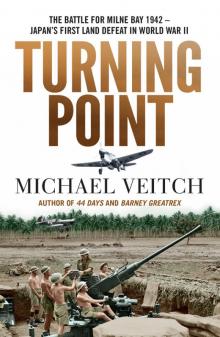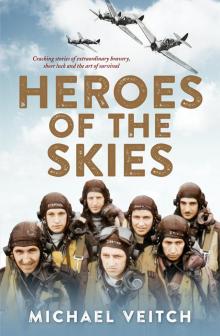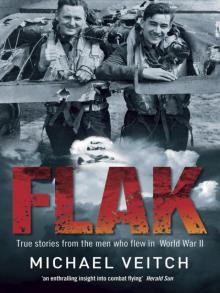- Home
- Michael Veitch
Turning Point Page 4
Turning Point Read online
Page 4
The problems he faced seemed insurmountable, beginning with the most basic, the complete lack of any decent maps of the area beyond a couple of colonial naval charts of dubious vintage. The men of the garrison would therefore have to make them themselves.
Margetts immediately divided the entire Milne Bay area into sections, each of which was assigned to an infantry officer of the 55th Battalion, who would use his army-issue compass and a prismatic rangefinder taken from a Bren machine gun to survey and map his section. Elementary in the extreme, it supplied just enough information to be collated and overlaid onto the existing naval chart, thus forming a series of maps that were eventually used in the battle itself.
Meanwhile, the Americans wasted no time beginning construction of the airstrip that was designated, quite logically, No. 1 Strip. The widest and flattest part of the coast was situated around Gili Gili, occupied mainly by the Lever Brothers’ coconut plantation, at that time one of the largest in the world. After a day or two of surveying, a 55-acre swathe, 300 feet by 8000 feet in size, was selected for its flatness and dryness. The latter was relative, however, with one end of what was to be the runway currently under a swamp, which would have to be drained.
The engineers of the 43rd began removing several thousand trees, blasting and bulldozing stumps and bush, using machines but with a considerable amount of work being done by hand. The technique of removing so many trees was testament to the industrial knowhow of the Americans. Entire rows of tree trunks were holed with a power drill, then small charges of gelignite were inserted in each and wired to a long cable. Then, at a command, an electric plunger was pushed, and the entire row would burst at their trunks, the upper fronds seeming almost to rise up and hang in the air for a moment before crashing to the ground.
The few bulldozers, graders, power shovels and dump trucks worked ceaselessly to clear the stumps and level the ground so that the steel matting could be laid. Even so, the engineers doubted the task could be completed in time. Sergeant Wilbert Block remembered:
The building of an airstrip in the middle of the jungles and swamps with mountains all around us, looked almost impossible with the equipment we had … when we first arrived, the ground seemed to be reasonably firm, but with the movement of all this equipment and constant rain, everything turned to mud.
In the memories of all who served at Milne Bay, the mud remained the salient feature, as it pervaded every aspect of life in the garrison. The three weeks prior to the arrival of the construction parties had seen tropical downpours lash the bay’s coast and the Stirling Range in a deluge heavy even by its standards. Many veterans, when later reflecting on their time at Milne Bay, do not remember the rain letting up for a moment. Men could literally shower outside. Flight Lieutenant Clive ‘Bardie’ Wawn of 76 Squadron witnessed a foot-deep tin outside his sodden tent fill from empty to overflowing overnight.
Streams from the 4000-foot-high mountains were transformed into mighty torrents, damaging – in some cases washing away – what few roads existed in the first place. Trucks and vehicles simply slid off the tracks as they became deeply rutted and impassable. Soon, only the most powerful of the American four-wheel drives could navigate the roads in any useful way; most of the Australian vehicles were two-wheel drives, which quickly became bogged. Many more roads would have to be built before the bulk of the 7th Brigade arrived.
Margetts ordered every man who could hold a shovel to go out and dig. To seal the surface of new roads, the trunks of the thousands of coconut trees were laid down, using the corduroy technique, which gave traction for a while. As heavy equipment began to churn up the surface, however, these eventually became unstable again.
Much of this work was carried out by Papuan labourers, recruited by the local ANGAU officers. The Australian and US servicemen were constantly astonished by their ability to work for long hours without complaint, and were surprised by their fluency in English; many in this part of New Guinea had been educated at mission schools. ANGAU officers were instructed to be attentive to the health of the labourers, as many local people had no immunity to diseases such as measles. Any Australian who presented with such an illness had to be quickly isolated; if necessary, they were removed.
The Australians and Americans were ravaged by similarly unfamiliar diseases, primarily malaria. A pre-war survey had found a highly malignant strain to be hyperendemic to this part of New Guinea, present in over 90 per cent of villages in the area. Within days, the first cases among the Allied service personnel started to present. According to one diary, by 11 July five men had been hospitalised with the disease; that doubled the next day. As more troops arrived over the coming weeks, the situation was exacerbated by poor medical advice and a lack of precautions for the tropical climate – so that by the time of the battle, some fighting units were reporting up to three-quarters of their men sick with various stages of the disease.
Dysentery was also common, and tropical parasites abounded. Initially at least, education as to their dangers was sorely lacking, and men began to present with such ailments as ear infections resulting from bathing in local creeks and streams. Bare skin coming into contact with earth could easily result in hookworm, and scratches from the abundant ‘wait-a-while’ sago palms and many other local bushes and shrubs could quickly become tropical ulcers, which were almost impossible to heal. Medical units would be put to the severest test just keeping the men fit. Private Allan Dolly of the 9th Battalion dubbed the Milne Bay fighting area ‘the last place God made and didn’t finish’.
Day by day, however, more men and equipment arrived, and more roads were established, or at least begun. Laying down crushed rock and coral was found to be a relatively effective way of securing the boggy road surfaces, and was in abundance along the long shoreline. Still, the road signs reading ‘Maximum Speed Limit 20 mph’ were looked on with wry humour.
In the days that followed the initial deployment, more ships arrived, including the British vessel Chochow, which pulled up at the Gili Gili wharf on 5 July, loaded with some of the tons of American steel Marston matting which would form the surfaces of the runways. Developed just the previous year by the Waterways Experiment Station, a research facility built by the US Army Corps of Engineers in Vicksburg, Mississippi, ‘perforated steel planking’ (or PSP) became known by the name of the small town in which it was first tested: Marston, North Carolina.
Strong, quick to construct and able to be manufactured in enormous quantities, the Marston mat enabled the establishment of forward airfields which could receive the heaviest aircraft in the most difficult of terrains. Rolled out in quarter-inch steel sheets with circular perforations to save weight, each piece was 10 feet long and 15 inches wide, and weighed about 70 pounds. A series of alternating tabs and grooves on each side secured one piece to another, like a giant jigsaw, and almost no further preparation was needed before the surface could accept aircraft.
Millions of sheets of Marston matting were produced throughout the war, and were used in almost every theatre: from Asia to Europe, the African desert, and even Alaska. Its first use, however, was at No. 1 Strip at Milne Bay, and it was an instant success.
The Australian soldiers at the improvised dock at Gili Gili, employed for now as wharf hands, could not fathom what these pallets of strange-looking steel plates could possibly be for as they came out of the holds of the ships, but they were soon to find out. And they would be very grateful for them indeed.
CHAPTER 5
WHERE ARE THE JAPANESE?
A little over two weeks elapsed at Milne Bay between the arrival of the US Engineers and their Australian guards on 25 June and the arrival of the garrison’s first proper reinforcements – in the form of the 7th Infantry Brigade – on 11 July, and they were perilous weeks in the extreme. Should the Japanese have chosen this moment to make their landing – as was widely expected – and secure Milne Bay for themselves, they would have met little opposition. When Major Margetts left Port Moresby for Gili Gili, he was blunt
ly told that, in the case of an attack by the Japanese, no help would be forthcoming.
This reality was also laid out to the men themselves. On a special parade on 7 July, the garrison was informed that, in the event of a Japanese assault, everyone – including gunners, radar operators and guards – were to assume themselves as infantry, inflict as much damage on the enemy as they could, and then head into the jungle and make for Port Moresby. Those unfamiliar with a rifle were told to learn how to handle one, and fast.
A direction like this from a distant HQ was all very well, but Margetts knew the entire area was essentially unmapped and unknown. This, at least, was a problem he could try to remedy. Soon after the mapping parties had commenced their rudimentary survey of the immediate environs, others were sent further afield to get the lay of the land: what it would be like to fight in, and – particularly – how to get out of it in a hurry.
In early July, two patrols from the 9th Light Anti-Aircraft Battalion were sent out, the first to reconnoitre an escape route to Mullins Harbour, about 25 miles away to the south-west. Led by Lieutenant Gerry Chambers, for three days the men pushed through jungle and up ridges to Mullins Harbour, with steadily increasing dread at what would be the consequences if the entire garrison had to join them along this tortuous route, particularly if fleeing the enemy. ‘There certainly wasn’t much feeling of victory in the air,’ he confessed in the unit’s official history.
Meanwhile, a second patrol was sent to explore the coastal track hugging the length of Milne Bay’s northern shore, the likely site of any Japanese landing. What was its condition? Where were the likely landing spots? How easy would it be to defend? All questions desperately requiring an answer. At dawn on 8 July, a three-man patrol – two coincidentally named ‘Paton’, Lieutenant Bruce Paton and Private Jim Paton, and Sergeant Scottie Quinn – were taken by boat 45 miles east, towards the mouth of the bay, to the Anglican mission at Dogura (sometimes referred to as ‘Dobodura’), from which point they would make their way back by land, heading west along the coastal track.
At Dogura, Lieutenant Paton and his men were presented with a curiously bucolic setting, distinctly at odds with the violence looming above them. Here, among the mission’s tidy lawns, orderly little church and playing fields, the staff seemed oblivious to the idea that their idyll was about to become a war zone. Father John Bodger, the minister in charge, greeted the men warmly and offered them a meal and bed for the night. Paton explained their mission, and Father Bodger offered to have a trusted local guide accompany them.
When Paton asked when the mission would be evacuated, he was met with incredulity. The missionaries had no intention of going anywhere, said Father Bodger. Paton’s entreaties – he even pointed out that people such as Bodger, as well as nurses and teachers, had already been murdered by the Japanese at places like Gona – fell on deaf ears. ‘We too have our duty to perform, Lieutenant,’ was the simple response.
At dawn the next day, after by far the most comfortable night the men had spent since their arrival at Milne Bay, Paton’s small party began their three-day journey back to Gili Gili. To see them off, some 50 of the mission’s schoolchildren lined up in order of height along the path, the girls on one side, the boys on the other, all impeccably dressed. As the soldiers passed between them, a perfect three-part harmony of ‘Auld Lang Syne’ rang out, resonating through the jungle. It was a moment of surreal beauty, but tinged with immense sadness; according to Paton, it was ‘a wonderful experience never to be forgotten’.
Proceeding west, Paton first addressed his primary task of noting possible landing areas that might be used by the enemy. These, he realised with dismay, were just about everywhere. Milne Bay’s naturally deep water and steeply falling shoreline were a boon to any ship seeking to pull up and disgorge its passengers and cargo. An invading Japanese landing party would be spoiled for choice among the many sheltered little coves Paton observed. The track itself, he also noted, would provide one of the most difficult battlegrounds imaginable, for both the attackers and the defenders. As he later wrote:
With the help of the trusted guide, it took three days to cover the distance from Dogura back to Milne Bay over some of the most tortuous country imaginable. Deep ravines alternating with high razorback ridges were the norm as the track, which was suitable for foot traffic only, wound its way through thick jungle for the entire distance.
His conclusion, however, was that, as difficult as this country was, the Japanese could indeed get through to Gili Gili.
The patrol spent two nights in villages high on the ridges, where they were looked after and fed with stews of sweet potato – all strictly paid for. The next morning, when they returned to the garrison, they found it had expanded dramatically in their brief absence. Even as they walked to the HQ staff tent to make their report, a long line of soldiers were disembarking from another large ship. The 7th Infantry Brigade, under Brigadier John Field, had arrived.
•
There are several reasons why John Field was the perfect choice to lead the men of the Milne Bay garrison at this early stage. He was, in the first instance, a thoughtful and intelligent commander who had already proved himself in battle, being Mentioned in Dispatches in 1941. Given command of the 2/12th Battalion – infantry volunteers from Tasmania and north Queensland – he had travelled with them across the Western Desert, fighting the Italians, Germans and Vichy French, bolstering the defences of Tobruk, then serving in Palestine and Syria.
He had a particular knack as a defensive strategist who would not be flustered into making a decision until he had considered all options and angles. And then he would approach his task with resolution and determination. Promoted to acting brigadier upon his return to Australia in May 1941, he was put in charge of the 7th Infantry Brigade, which was to be incorporated into a new, larger force for a purpose so specific that it was to be given a title to match: Milne Force.
However, perhaps Field’s most distinguishing qualification was that he was a fully qualified, as well as highly respected, engineer. Born in Castlemaine, Victoria, in 1899, the young John Field was apprenticed to an engineering firm by the age of fifteen, rising in a few years to become the senior draftsman, specialising in centrifugal pumps and pumping plants. By age 26, he was lecturing on the subject at the University of Tasmania, while also climbing up the ranks of the Citizen Military Forces, in which he was made a major shortly before the outbreak of war in 1939.
It was with no little urgency that Field had been brought back from the Middle East. With northern Australia perceived to be under threat of invasion, his capabilities in engineering and defensive construction landed him the job of training the 7th Brigade to meet a Japanese invasion where it was most expected: at Rollingstone, 31 miles north of Townsville. Here, much to the outrage of some of the local sugar cane farmers, who wailed for compensation for the damage wrought on their land, he trained his men to dig in and build. So much work was needed, however, that Field spent little time instructing his infantrymen on how to actually fight.
In the event, no invasion by the Japanese was forthcoming at Rollingstone, nor anywhere else on the Australian mainland, but the threat further to the north was real enough. As Field recorded in his diary:
We’d just begun the training programme when we were ordered to Milne Bay. Liaison Officer Struss came to see me with the cryptic statement, ‘The show is on!’ There had been no prior information passed to me on the possibility of a move. Such is the fog of war.
Behind the scenes, things had been moving quickly. As the initial establishment of Milne Bay got underway, General MacArthur decided to reinforce it, though initially with only a single battalion. The commander-in-chief of the Australian forces, General Thomas Blamey, was incensed. Enough ‘penny packets’ of Australian soldiers, he pointed out, had already been sent into the islands to be swallowed up and annihilated by the Japanese juggernaut. This time, he insisted, ‘a self-contained fighting force’ must be sent. His argument won th
e day, and Field’s 7th Brigade – comprising three militia battalions, now digging in around Townsville – was chosen.
Field was not to be overwhelmed by the many problems confronting him upon his arrival at Milne Bay on 11 July 1942. Indeed, his very first morning at the garrison had been an eventful one. As soon as the Tasman, another venerable Dutch KPM freighter, pulled up to the wharf carrying the forward elements of Field’s 7th Brigade, an agitated naval officer, Sub-Lieutenant Ivan Champion, raced up the gangway to alert his new CO of Japanese aerial activity which had been observed overhead all morning.
A childhood friend of Mac Rich, Champion was likewise a former patrol officer and long-time resident of Papua. He had already notched up one close encounter with the Japanese when, the previous April, he had swung his requisitioned Papuan government motor vessel, HMAS Laurabada, into a beach at Jacquinot Bay in New Britain. Here, under the noses of the Japanese, he spirited away 156 desperate Australian military and civilian personnel fleeing the Japanese after the fall of Rabaul. The old ship – whose armament consisted of a solitary machinegun – groaned with the weight, but Champion delivered everyone safely to Port Moresby.
Along with everyone else at the garrison, Champion simply could not believe the Japanese had not already discovered their presence, not to mention the half-completed No. 1 Strip, which was now expanding into the jungle a mile or so away. Japanese aircraft had been coming and going sporadically over the fortnight since their arrival, but the expected attack had failed to materialise. While the men of the garrison were relieved, it was somewhat unnerving. Soon the dismal rumour began to spread that the Japanese were actually waiting for the strip to be completed before launching their invasion, at which point they would simply walk in and take it. The notion did nothing to lift the pall hanging over the garrison.
Nevertheless, the strongest measures to conceal their existence continued to be observed. Radio silence was strictly enforced, with messages received but not broadcast, radar sets were forbidden to be switched on, and no gun was permitted to open fire on any curious Japanese aircraft that might be lurking overhead.

 Turning Point
Turning Point Heroes of the Skies
Heroes of the Skies The Forgotten Islands
The Forgotten Islands Hell Ship
Hell Ship Flak
Flak Fly
Fly